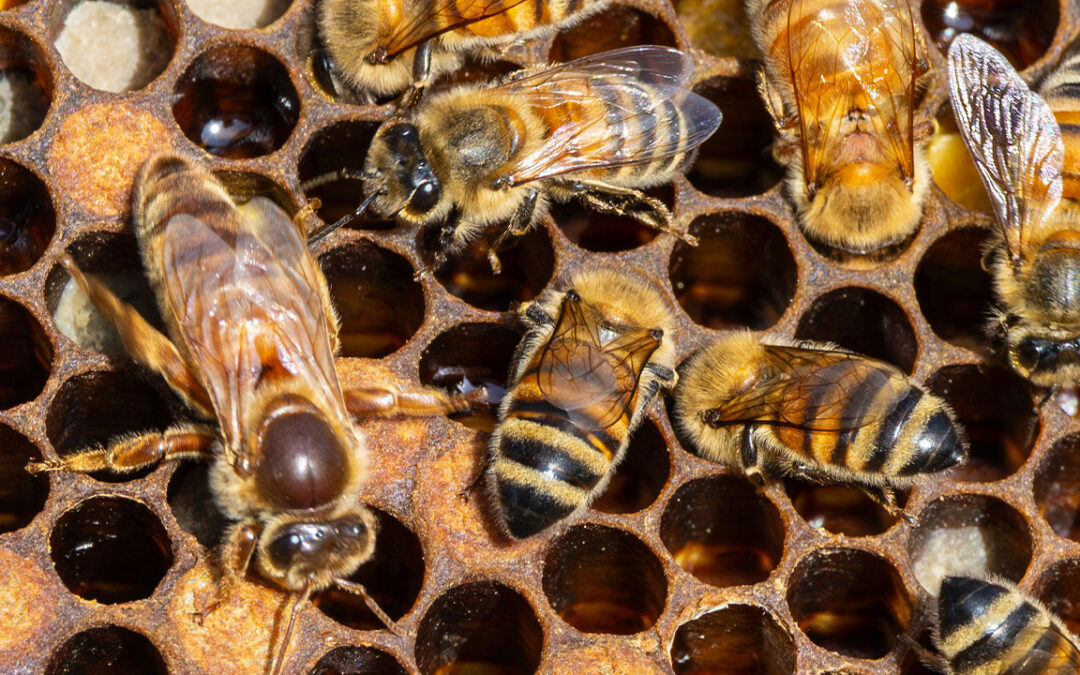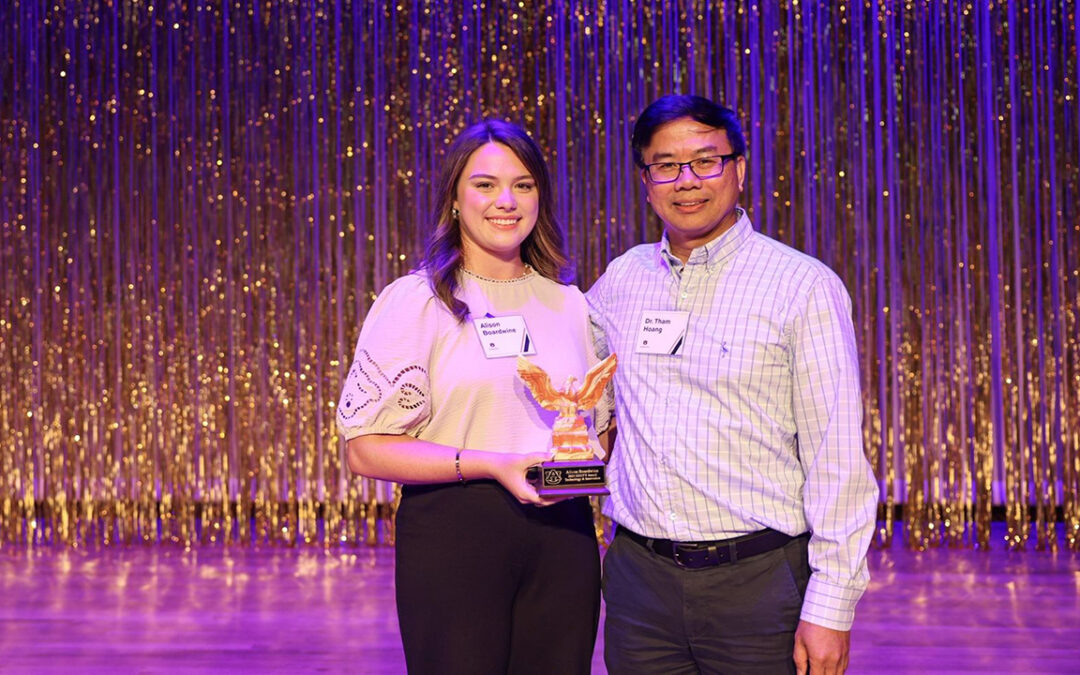It was in Honduras, at the Soto Cano Air Base, where Capt. Tolulope Morawo and Lt. Col. Steven “Mark” Pelham met an enemy they had never encountered before.
Morawo, an entomologist, and Pelham, a veterinarian, were on Army Reserve deployment facing the New World Screwworm fly (Cochliomyia hominivorax), a parasitic insect whose larvae feed on the living tissue of warm-blooded animals — most commonly livestock. Infestations can cause severe wounds, infection and even death, making it a significant threat to agriculture and public health in regions where it is present.
Together, they put their respective expertise to good use. And for months, they worked alongside one another before realizing they had something in common.
They are both Auburn University alumni.
Assessing the problem

Photo courtesy of Capt. Tolulope Morawo
Neither Morawo nor Pelham had treated or responded to the New World Screwworm fly prior to this deployment. Typically about the same size or slightly larger and shinier than the common housefly, it lays eggs into fresh wounds in any warm-blooded animal, including humans.
“Females of the fly will lay a bunch of eggs in the same spot on an open wound, and they will multiply en masse,” Morawo said. “Once the eggs hatch into larvae, they attack — hundreds of them, burrowing into the wound, hence the name screwworm — which is what causes then a really big wound.”
A major difference from other fly species is that the larvae of most flies feed on dead tissue. But this fly feeds on tissues that are still alive.
“It is almost eating the animal alive,” Morawo said. “Then the cattle get predisposed to other infections through that wound, plus just loss of tissues and blood can lead to death of the cattle.”
Though stationed in Honduras, Morawo and Pelham covered much of Central America. It did not take long for the urgency of the New World Screwworm fly issue in their region to be made clear.
Morawo, a native of Nigeria who earned his Master of Science from Auburn in 2013 and his doctorate in 2017, was part of the preventive medicine unit. The unit’s entomologist will do entomological surveillance for vector-borne diseases, food sanitation inspection and anything that helps ensure service members are staying healthy.
Within each nine-month deployment, there is just one entomologist in the unit.
Meanwhile, Pelham was the one veterinarian on the veterinary team. Many of his off-post excursions were spent doing global veterinary health engagements, working with the local farmers and their herds. In several countries, the task was to prevent screwworm fly infestations through proper wound care.
“We’d show them how to vaccinate and take care of their cattle,” said Pelham, who earned his Doctor of Veterinary Medicine from Auburn in 1993. “These were horned cattle, and you always find wounds on them. So, we were showing them how to really look at those wounds, identify if they were seeing any screwworm issues, and if there were none, treating the wound to keep those flies from getting to them with some topical sprays and things they could apply to try to prevent the infestation.”
If they did find evidence of infestation, they would treat using ivermectin injections.
“We were always stressing the importance of finding that early to save the cattle, because agriculture really is their way of life,” Pelham said. “Infestations were very, very impactful to the farmer, to the economy, to the agricultural industry as a whole.”
“We were able to see it firsthand in that region, especially with the cattle industry,” Morawo agreed. “They really struggled with it.”
A major part of Pelham’s care duties included military working dogs on the base.
“We had to be careful to implement procedures for checking those dogs twice daily — every morning, every evening — to make sure there were no cuts or scratches that could invite that infestation,” he said. “Those dogs are very valuable to us, very important to the force as well as very expensive from the training they’ve had. So, we had to protect that asset, too, and it became a base concern that we made sure we were looking after them, too.”
For several months, the two teams worked independently to address the problem in the region, until Morawo brought in the USDA and set up a meeting bringing the teams together.
“You can get siloed out there,” Pelham explained. “You won’t realize you’re both working on something similar, and you just haven’t come together to work on it together yet. Especially with him being on the entomology side and I was on the animal side.”
Addressing the issue

Photo courtesy of Capt. Tolulope Morawo
The United States has a long history of combating the New World Screwworm fly, beginning in the 1950s when infestations were causing widespread losses in livestock. Scientists with the USDA-ARS developed the sterile insect technique, which proved highly effective, and by the early 1960s, the screwworm was eradicated from the continental U.S.
“The most sustainable way to control the fly is the sterile insect technique,” Morawo said. “You rear and sterilize males of the same species, take an aircraft to distribute those males en masse, and then just rain them down through the skies.”
Female New World Screwworm flies only mate once. If the sterilized males outnumber the wild ones and mate with wild females, their offspring will not be viable, and the fly can be eradicated over time.
The USDA eradication program was successful and pushed all cases of the flies in the wild down to Mexico and southward.
“So they moved the eradication efforts down to Mexico,” Morawo explained. “And as they pushed the pests down, they kept pushing southward, southward, until they got to Panama, where they kind of just set the barrier, so to say. In the rest of South America, the pest is endemic there. It’s always been there and is still there, anywhere south of Panama.”
For decades now, the USDA, in collaboration with Central American countries, has continued routine sterile male fly drops. But in the last year and a half, the flies have crept their way north of Panama again, into Costa Rica, Nicaragua, Honduras, Guatemala, Belize and even parts of Mexico.
“They’ve had to ramp up production of those flies because now they need to supply all those countries that are north of Panama, and it becomes a threat to the U.S. again,” said Morawo. “In fact, the USDA announced plans this month to build a new sterile fly production facility in Texas to combat the New World Screwworm. I was able to tour the fly rearing facility and observe aerial fly dispersal operation in Honduras. It was really good to get to see all that stuff.”
Serving their country
Neither Morawo nor Pelham had the most traditional paths to careers in the military.
Pelham, who has now been in the military for 16 years, joined when he was 40. There was a shortage of military veterinarians during the Gulf War, and he qualified for an age waiver because of the wartime need.
“My father came from a military background, and I thought I had missed my opportunity in life because I was 40. Now 40 doesn’t seem old, but it was old for the military. But, you know, I didn’t hesitate. I think within three weeks I was being sworn in to join, and I haven’t looked back.
“When I first went in, I said, well, you know, I’ll go in four or five years and do my duty. And here I am, 16 years later. I was just trying to help fill a gap and a need at the time.”
Morawo, meanwhile, completed a postdoc at Auburn in 2020 and then went to the University of Florida, where he worked as an assistant professor for a year. He left to join the U.S. Navy as a civilian entomologist.
“But I actually joined the Army Reserves while I was at Auburn,” he said. “That was in 2019. I was doing my postdoc at Auburn at the time.”
He had attended a meeting of the Entomological Society of America while still a master’s student, where the U.S. Army had a recruiting booth. It immediately intrigued him — the idea of serving in the Armed Forces as an entomologist.
“I didn’t think it was a job on its own in the military,” he said.
He knew he couldn’t balance completing his degrees and joining, but the idea stayed with him.
“I just had it in the back of my mind, okay, at some point, I’m going to be done with my studies, and I will consider doing this,” he said. “So, I graduated with my Ph.D. in 2017, and I was able to start the process of joining in 2018, and I commissioned in 2019.”
Morawo described the experience of a reservist as having two jobs.
“Our full-time job is our civilian job, our professional job, and then our part-time job is the Army Reserves,” he said. “Now, sometimes that part-time becomes full-time, which is kind of a unique professional experience that a lot of people don’t get an opportunity to have — being able to pursue your civilian professional career and, at the same time, serve your country.”
That dichotomy holds true for Pelham, as well. He began his veterinary career in small animal medicine in Las Vegas, working with some big names in veterinary medicine. He came back to Birmingham, where he set up shop and practiced for many years. Now, he is a
professional services veterinarian for Merck Animal Health.
That is, when he’s not healing cattle in Central America.
Leaving as family
So what are the odds of two Auburn alumni being stationed as subject matter experts at Soto Cano Air Base together to work on a critical, specialized issue?
Low.
“He was the only veterinarian, I was the only entomologist in the whole region at the time,” Morawo said. “It’s usually just one of each subject matter experts that they deploy there for the nine months, and then they switch out and rotate.”
Pelham said they had been working together for months before they realized they were both Auburn alumni.
“When I’m on deployment, I’ve always got my Auburn flag in my room,” he said. “I’ve got my Auburn T-shirt, you know, that I’m wearing on base when we’re not in uniform. So, we were just out and about. We would go to the capital city in Honduras sometimes just to get out on weekends. And I had on my Auburn hoodie.
“We were just like, what are the odds? But you know what, I think on both big deployments I’ve been on, I’ve run into Auburn people.”
Pelham said finding out he was working with a fellow alum created an even tighter working relationship, and it was particularly meaningful as they addressed an issue that could have great implications for their country.
“We were already working together, but the minute you find out, ‘Here’s another Auburn person and Auburn grad,’ it just does just change that whole relationship,” he said. “We’ve gone through similar coursework, we’ve both been on Ag Hill.
“To me, this just shows the difference that is the Auburn Family.”





